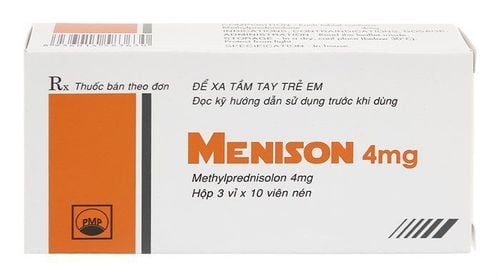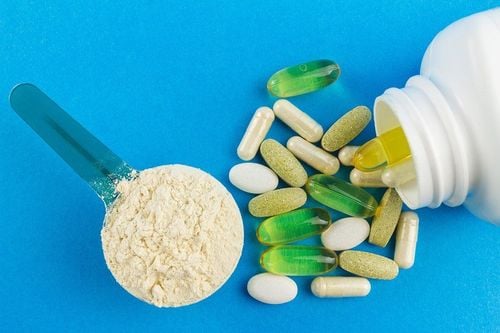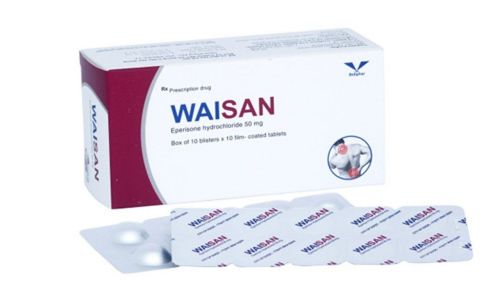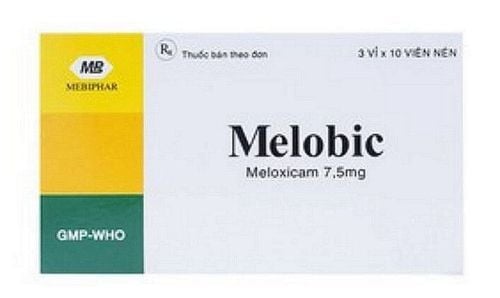This is an automatically translated article.
Oracu belongs to the group of pain relievers, antipyretics, non-steroidal anti-inflammatory drugs, treating gout and bone and joint diseases. Oracu is prepared in the form of hard capsules, packed in boxes of 10 blisters x 10 tablets or 3 blisters x 10 tablets. Before using Oracu, patients should consult a doctor or pharmacist. The following is some information to help better understand what Oracu does?
1. What is the effect of Oracu?
Oracu medicine contains the main ingredient is Diacerhein 50mg.
Pharmacodynamics:
The results of several studies show that Diacerein and Rhein, its active metabolites, inhibit the production and activity of Interleukin-1, a proinflammatory and pro-catabolic substance, both in the superficial and deep layers of the cartilage, in the synovial membrane and in the synovial fluid. It also stimulates the production of transforming growth factor-α (TGF-β) and components of the extracellular matrix such as aggrecan, proteoglycan, hyaluronic acid and type II colloid.
In addition, these substances also inhibit phagocytosis and migration of macrophages. Studies in several animal models of osteoarthritis have shown that Diacerein consistently reduces cartilage degeneration compared with untreated groups. At the same time, there was a significant reduction in pain and a significant improvement in joint function compared with placebo after 1 month of treatment with Diacerein. Other studies have also shown that the beneficial effects of Diacerein treatment persisted for at least 2 months after treatment was discontinued.
Pharmacokinetics:
After oral administration, Diacerein passes through the liver and is completely deacetylated to rhein. This substance is sulpho-conjugated. Following oral administration of a single 50 mg dose of Diacerein, peak plasma concentrations occur at approximately 2.5 hours. Taking Diacerein with meals increases bioavailability. When a dose of 50 mg to 200 mg of Diacerein was administered as a single dose, all pharmacokinetic parameters were independent of dose. The association with protein is very high (99%). This is mainly due to the strong binding affinity for albumin. The half-life of rhein is about 4.5 hours. The total amount of drug excreted in the urine is about 30%. Approximately 80% of rhein is excreted in the urine as sulpho and glucuroconjugated conjugates and about 20% as unchanged rhein. After repeated dosing (50 mg twice daily), Diacerein showed slight accumulation. In patients with severe renal impairment (creatinine clearance less than 30 ml/min), the AUC and half-life were doubled and urinary excretion halved. Oracu is indicated for the treatment of symptoms of osteoarthritis.
2. Dosage and how to use Oracu
Usage: Oracu drug is taken orally.
Dosage:
For adults: Take 2 tablets/day x 2 times, during meals. For patients with renal impairment: The dose of Oracu should be halved in patients with creatinine clearance less than 30 ml/min. Note: Oracu dosage above is for reference only. The specific dose of Oracu depends on the condition and the progression of the disease. To get the right dose of Oracu, patients should consult their doctor or healthcare professional.
3. Oracu side effects
Oracu has a high level of safety and is less likely to have unwanted side effects. However, taking Oracu in high doses or for a long time can cause undesirable effects such as a rapid increase in the time it takes for food to pass through the intestines and abdominal pain. This side effect may appear within the first few days of treatment and in most cases will resolve on its own with continued treatment.
In addition, when taking Diacerein can also make the urine darker yellow.
If experiencing these symptoms, the patient should stop using Oracu and notify the doctor for appropriate treatment.
4. Oracu drug interactions
Oracu if used concurrently with drugs containing salt, calcium and magnesium, oxide or aluminum hydroxide will reduce the absorption of Diacerein. If they must, they can be used at another time (about 2 hours) after taking Oracu.
Although dangerous interactions caused by drugs or foods have not been detected with Oracu, it cannot be subjective. Patients need to actively exchange all health information as well as drug use status at the time of prescription with the doctor. The information provided can be the basis for doctors to assess the risk of drug interactions with Oracu after use.
4. Precautions when using Oracu
Do not give Oracu to children under 15 years of age because there are no clinical studies in this age group. Oracu should not be used concurrently with laxatives. Oracu should not be used by pregnant women. In addition, Oracu should not be prescribed to women who are breastfeeding because small amounts of diacerein derivatives have been reported to pass into breast milk. There have been no reports of harmful effects of Oracu on the ability to concentrate when driving or operating machinery or equipment. In the event of a missed dose of Oracu, it is advisable to make up for it as soon as possible. However, if it is almost time for the next dose, skip the missed dose of Oracu and use a new dose. When using Oracu drug overdose, the patient should stop the drug immediately and go to the nearest medical facility for timely treatment. Absolutely do not use when Oracu has signs of discoloration, mold, watery or expired. The article has provided information on dosage, contraindications and notes during use and Oracu's therapeutic uses. To ensure that Oracu works optimally and to prevent side effects, patients should consult their doctor/pharmacist before use.
Please dial HOTLINE for more information or register for an appointment HERE. Download MyVinmec app to make appointments faster and to manage your bookings easily.













